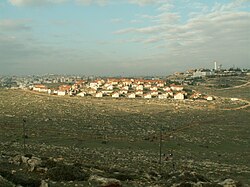Beit Hagai
בֵּית חַגַּי | |
|---|---|
| Hebrew transcription(s) | |
| • official | Haggay |
| • unofficial | Hagai |
 | |
| Coordinates: 31°29′35″N 35°4′51″E / 31.49306°N 35.08083°E | |
| District | Judea and Samaria Area |
| Council | Har Hevron |
| Region | West Bank |
| Affiliation | Amana |
| Founded | 1984 |
| Population (2022)[1] | 725 |
| Website | pisrael.com/betHagay/ |
Beit Hagai (Hebrew: בֵּית חַגַּי, Arabic: بيت حجاي), also Hagai, is an Israeli settlement organized as a community settlement located in the southern Hebron Hills in the West Bank. The settlement population was 460 in 2004, according to a classified government document published by the Haaretz newspaper,[2] and lies within the municipal jurisdiction of the Har Hevron Regional Council. The religious Jewish community's name, Haggai, is an acronym of the given names Hanan Krauthammer, Gershon Klein, and Yaakov Zimmerman, three Nir Yeshiva (Kiryat Arba) students murdered in the 1980 Hebron terrorist attack.[3] The community rabbi for Beit Hagai is Rabbi Moshe Eliezer Rabinovich (HaLevy). In 2022 it had a population of 725. The international community considers Israeli settlements in the West Bank illegal under international law, but the Israeli government disputes this.[4][5]
- ^ "Regional Statistics". Israel Central Bureau of Statistics. Retrieved 21 March 2024.
- ^ Secret Israeli Database Reveals Full Extent of Illegal Settlement Haaretz, 1 January 2009
- ^ "The Six Murdered Outside Beit Hadassah". Jewish Community of Hebron. 2006-07-19. Archived from the original on 2010-02-19. Retrieved 2007-11-07.
- ^ "The Geneva Convention". BBC News. 10 December 2009. Retrieved 27 November 2010.
- ^ Regarding international organizations and courts of law, see [1] Archived 2014-09-13 at the Wayback Machine; regarding the UN, see UN General Assembly resolution 39/146, 14 December 1984; UN Security Council Resolution 446, 22 March 1979; and International Court of Justice Advisory Opinion, 9 July 2004, Legal Consequences of the Construction of a Wall in the Occupied Palestinian Territory, para 120; Regarding the European Union position, see [2]; for Canada's position, see [3] Archived 2018-02-18 at the Wayback Machine
